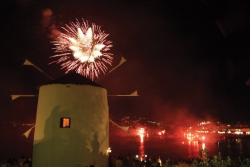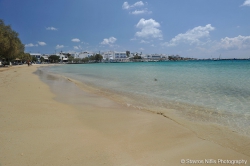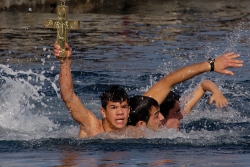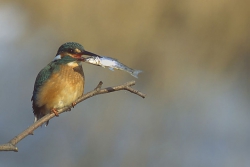Traditional Dance Troupes
Tradition is the melodic lullaby sung by mother, the legends told by grandfather, carols, birdsong, serenades, customs, dances and the goals that accompany every joy, the costumes, the embroidery, the couplets, the games and anything else that is part of the life on our island.
The Ageranos is a traditional dance of Paros, a revival of the older mixed dance of Antiquity, according to Kyriaki Ragousi- Kontogiorgou.
Pursuant to an announcement made by archaeologist-musicologist Zozis Papadopoulos, a ceramic tile from the geometric period, which was found during the excavation of the Delios archaeological site on Paros, depicts naked men dancing the Ageranos.
Many respected travelers, scholars, writers, archaeologists and musicologists studied the Ageranos. Choiseul Gouffier named the Parian dance Romeca, although he linked it with other ancient dances. As regards the term Romeca, Alexandra Voutyra argued in her lecture "The depiction of Dance by European Travelers of the 18th and 19th Century", that the Romeca are variations of the Syrto dance and and were so named because of the fact that every traveler who came to Greece brought a Turkish firman (royal mandate or decree) to facilitate their travels, as well as a Dragoumanos (translator) as they didn't speak the language.
When the traveler asked, "What do they dance here?" the likely response was that they danced the Romeca, in reference to the nationality and not the type of the dance. After all, the term is not used by Greek writers, according to Alkis Raftis. However, according to Georgios Roubis, the Romeca are not variations of the Syrto dance, but a different kind of Syrto, as the dance occurs with various alterations throughout Greece, and most importantly, is mixed - in contrast with the descriptions and illustrations of the specific dance by certain travelers.
Pierre Augustin de Guys, the 18th century French traveler, describes the dance accurately: "The lead woman takes a man by the hand, spreading the handkerchief, and the couple holds the handkerchief at each end while the entire line of other male and female dancers pass between them again and again, ducking their heads under the handkerchief."
The dance initially moves slowly and in a circular motion. Afterwards, the lead woman moves about and guides the dance around her. Her trick is to detach herself from the line and suddenly reappear again at the front of the dance moving in concentric circles and triumphantly waving her handkerchief.
German J.H. Riedesel, noted around 1768 that Parian women were thought to be the best dancers in the Aegean, particularly in the Romeca, which is considered a very polite dance. Byzantologist and academic Faidon Koukoules describes the Ageranos as a Cycladic dance with many maneuvers. A special song, called ageranos, is chanted during the dance, during which the dancers take three quick steps to the right and one to the left. The dancers move around, and each one supports themselves by placing an arm on their partner's shoulder, and this is perhaps explains the ancient "person supporting person".
Dora Stratou says of the Ageranos of Paros, "A couple stands to one side and the other couples join them. When the group forms a coil, the uncoiling begins with the couple on the end. It is usually sung and danced without musical accompaniment. The dancers take each other by the shoulders and the steps are slow for the first half of the music, while the second half is springy and much faster."
The traditional dances of Paros are accompanied by the violin, lute, bagpipes and "tympaki" (a small drum).













